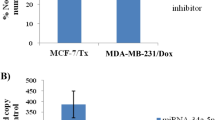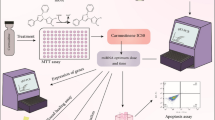Abstract
Drug resistance is one of the major challenges for cancer therapies. In recent years, research on disease-related molecular signaling pathways has become the key ways to understand and overcome obstacles. Dysregulation of MALAT1 could regulate doxorubicin resistance of hepatocellular carcinoma (HCC), but how MALAT1 involving in managing doxorubicin resistance remains unclear yet. We aimed to elucidate the specific molecular mechanism of MALAT1 with doxorubicin resistance in HCC cells. Quantitative real-time polymerase chain reaction (qRT-PCR) was engaged to detect the expression levels of MALAT1, miR-3129-5p and Nova1 mRNA; MTT, western blot, flow cytometry and luciferase reporter assays were executed to identify the influence of MALAT1 on doxorubicin resistance of HCC cells. Xenograft tumor model was created to confirm the biological function of MALAT1 in doxorubicin resistance of HCC cells in vivo. MALAT1 and Nova1 were upregulated, while miR-3129-5p expression was decreased in doxorubicin-resistant HCC tissues and cells. Knockdown of MALAT1 regulated doxorubicin resistance of HCC cells through inhibiting cell proliferation, migration, invasion and promoting apoptosis, but antisense miR-3129-5p released the functional effect of MALAT1 knockdown. Nova1, as a target gene of miR-3129-5p, reversed the results of miR-3129-5p expression and enhanced doxorubicin resistance of HCC cells. Xenograft tumor model suggested that dysregulation of MALAT1 regulated tumor growth and Nova1 to mediate doxorubicin resistance of HCC cells by as a sponge for miR-3129-5p in vivo. Elevation of LncRNA MALAT1 mediated doxorubicin resistance and the progression of HCC via a MALAT1/miR-3129-5p/Nova1 axis. This study would be expected to enrich the understanding of doxorubicin resistance of HCC and provide new ideas for HCC treatment strategies.








Similar content being viewed by others
References
Bray F, Ferlay J, Soerjomataram I, Siegel RL, Torre LA, Jemal A (2018) Global cancer statistics 2018: GLOBOCAN estimates of incidence and mortality worldwide for 36 cancers in 185 countries. CA Cancer J Clin 68:394–424. https://doi.org/10.3322/caac.21492
Dimitroulis D, Damaskos C, Valsami S, Davakis S, Garmpis N, Spartalis E, Athanasiou A, Moris D, Sakellariou S, Kykalos S, Tsourouflis G, Garmpi A, Delladetsima I, Kontzoglou K, Kouraklis G (2017) From diagnosis to treatment of hepatocellular carcinoma: an epidemic problem for both developed and developing world. World J Gastroenterol 23:5282–5294. https://doi.org/10.3748/wjg.v23.i29.5282
Marengo A, Rosso C, Bugianesi E (2016) Liver cancer: connections with obesity, fatty liver, and cirrhosis. Annu Rev Med 67:103–117. https://doi.org/10.1146/annurev-med-090514-013832
Massoud O, Charlton M (2018) Nonalcoholic fatty liver disease/nonalcoholic steatohepatitis and hepatocellular carcinoma. Clin Liver Dis 22:201–211. https://doi.org/10.1016/j.cld.2017.08.014
Hartke J, Johnson M, Ghabril M (2017) The diagnosis and treatment of hepatocellular carcinoma. Semin Diagn Pathol 34:153–159. https://doi.org/10.1053/j.semdp.2016.12.011
Haberal M, Akdur A, Moray G, Arslan G, Ozcay F, Selcuk H, Ozdemir H (2017) Expanded criteria for hepatocellular carcinoma in liver transplant. Exp Clin Transpl 15:55–58. https://doi.org/10.6002/ect.TOND16.L14
Iguchi T, Uchi R, Nambara S, Saito T, Komatsu H, Hirata H, Ueda M, Sakimura S, Takano Y, Kurashige J, Shinden Y, Eguchi H, Sugimachi K, Maehara Y, Mimori K (2015) A long noncoding RNA, lncRNA-ATB, is involved in the progression and prognosis of colorectal cancer. Anticancer Res 35:1385–1388 PMID: 25750289
Yang B, Wei ZY, Wang BQ, Yang HC, Wang JY, Bu XY (2018) Down-regulation of the long noncoding RNA-HOX transcript antisense intergenic RNA inhibits the occurrence and progression of glioma. J Cell Biochem 119:2278–2287. https://doi.org/10.1002/jcb.26390
An J, Lv W, Zhang Y (2017) LncRNA NEAT1 contributes to paclitaxel resistance of ovarian cancer cells by regulating ZEB1 expression via miR-194. Onco Targets Ther 10:5377–5390. https://doi.org/10.2147/OTT.S147586
Majidinia M, Yousefi B (2016) Long non-coding RNAs in cancer drug resistance development. DNA Repair (Amst) 45:25–33. https://doi.org/10.1016/j.dnarep.2016.06.003
Shi SJ, Wang LJ, Yu B, Li YH, Jin Y, Bai XZ (2015) LncRNA-ATB promotes trastuzumab resistance and invasion-metastasis cascade in breast cancer. Oncotarget 6:11652–11663
Zhang CL, Zhu KP, Ma XL (2017) Antisense lncRNA FOXC2-AS1 promotes doxorubicin resistance in osteosarcoma by increasing the expression of FOXC2. Cancer Lett 396:66–75. https://doi.org/10.1016/j.canlet.2017.03.018
Li Z, Qian J, Li J, Zhu C (2019) Knockdown of lncRNA-HOTAIR downregulates the drug-resistance of breast cancer cells to doxorubicin via the PI3K/AKT/mTOR signaling pathway. Exp Ther Med 18:435–442. https://doi.org/10.3892/etm.2019.7629
Zhu QN, Wang G, Guo Y, Peng Y, Zhang R, Deng JL, Li ZX, Zhu YS (2017) LncRNA H19 is a major mediator of doxorubicin chemoresistance in breast cancer cells through a cullin4A-MDR1 pathway. Oncotarget 8:91990–92003
Li P (2017) <MALAT1 is associated with poor response to oxaliplatin-based chemotherapy in.pdf>. Mol Cancer Ther 16:739–751. https://doi.org/10.1158/1535-7163.MCT-16-0591
Yuan P, Cao W, Zang Q, Li G, Guo X, Fan J (2016) The HIF-2alpha-MALAT1-miR-216b axis regulates multi-drug resistance of hepatocellular carcinoma cells via modulating autophagy. Biochem Biophys Res Commun 478:1067–1073. https://doi.org/10.1016/j.bbrc.2016.08.065
Yu Q, Xiang L, Chen Z, Liu X, Ou H, Zhou J, Yang D (2019) MALAT1 functions as a competing endogenous RNA to regulate SMAD5 expression by acting as a sponge for miR-142-3p in hepatocellular carcinoma. Cell Biosci 9:39. https://doi.org/10.1186/s13578-019-0299-6
Dehghanzadeh R, Jadidi-Niaragh F, Gharibi T, Yousefi M (2015) MicroRNA-induced drug resistance in gastric cancer. Biomed Pharmacother 74:191–199. https://doi.org/10.1016/j.biopha.2015.08.009
Yang W, Ma J, Zhou W, Cao B, Zhou X, Yang Z, Zhang H, Zhao Q, Fan D, Hong L (2017) Molecular mechanisms and theranostic potential of miRNAs in drug resistance of gastric cancer. Expert Opin Ther Targets 21:1063–1075. https://doi.org/10.1080/14728222.2017.1389900
Zhang Y, Wang J (2017) MicroRNAs are important regulators of drug resistance in colorectal cancer. Biol Chem 398:929–938. https://doi.org/10.1515/hsz-2016-0308
Yu DD, Lv MM, Chen WX, Zhong SL, Zhang XH, Chen L, Ma TF, Tang JH, Zhao JH (2015) Role of miR-155 in drug resistance of breast cancer. Tumour Biol 36:1395–1401. https://doi.org/10.1007/s13277-015-3263-z
Yang W, Ma J, Zhou W, Zhou X, Cao B, Zhang H, Zhao Q, Fan D, Hong L (2017) Molecular mechanisms and clinical implications of miRNAs in drug resistance of esophageal cancer. Expert Rev Gastroenterol Hepatol 11:1151–1163. https://doi.org/10.1080/17474124.2017.1372189
Hong L, Han Y, Zhang H, Zhao Q, Wu K, Fan D (2014) Drug resistance-related miRNAs in hepatocellular cancer. Expert Rev Gastroenterol Hepatol 8:283–288. https://doi.org/10.1586/17474124.2014.881713
Long L, Xiang H, Liu J, Zhang Z, Sun L (2019) ZEB1 mediates doxorubicin (Dox) resistance and mesenchymal characteristics of hepatocarcinoma cells. Exp Mol Pathol 106:116–122. https://doi.org/10.1016/j.yexmp.2019.01.001
Li C, He Y, Ma H, Han S (2017) NOVA1 acts as an oncogene in osteosarcoma. Am J Transl Res 9:4450–4457
Kim EK, Yoon SO, Jung WY, Lee H, Kang Y, Jang YJ, Hong SW, Choi SH, Yang WI (2017) Implications of NOVA1 suppression within the microenvironment of gastric cancer: association with immune cell dysregulation. Gastric Cancer 20:438–447. https://doi.org/10.1007/s10120-016-0623-3
Li H, Lv B, Kong L, Xia J, Zhu M, Hu L, Zhen D, Wu Y, Jia X, Zhu S, Cui H (2017) Nova1 mediates resistance of rat pheochromocytoma cells to hypoxia-induced apoptosis via the Bax/Bcl-2/caspase-3 pathway. Int J Mol Med 40:1125–1133. https://doi.org/10.3892/ijmm.2017.3089
Zhang YA, Liu HN, Zhu JM, Zhang DY, Shen XZ, Liu TT (2016) RNA binding protein Nova1 promotes tumor growth in vivo and its potential mechanism as an oncogene may due to its interaction with GABAA Receptor-gamma2. J Biomed Sci 23:71. https://doi.org/10.1186/s12929-016-0288-6
Zhi F, Wang Q, Deng D, Shao N, Wang R, Xue L, Wang S, Xia X, Yang Y (2014) MiR-181b-5p downregulates NOVA1 to suppress proliferation, migration and invasion and promote apoptosis in astrocytoma. PLoS ONE 9:e109124. https://doi.org/10.1371/journal.pone.0109124
Zhang YA, Zhu JM, Yin J, Tang WQ, Guo YM, Shen XZ, Liu TT (2014) High expression of neuro-oncological ventral antigen 1 correlates with poor prognosis in hepatocellular carcinoma. PLoS ONE 9:e90955. https://doi.org/10.1371/journal.pone.0090955
Jin F, Wang Y, Li M, Zhu Y, Liang H, Wang C, Wang F, Zhang CY, Zen K, Li L (2017) MiR-26 enhances chemosensitivity and promotes apoptosis of hepatocellular carcinoma cells through inhibiting autophagy. Cell Death Dis 8:e2540. https://doi.org/10.1038/cddis.2016.461
Zhang X, Hamblin MH, Yin KJ (2017) The long noncoding RNA Malat 1: its physiological and pathophysiological functions. RNA Biol 14:1705–1714. https://doi.org/10.1080/15476286.2017.1358347
Bai L, Wang A, Zhang Y, Xu X, Zhang X (2018) Knockdown of MALAT1 enhances chemosensitivity of ovarian cancer cells to cisplatin through inhibiting the Notch1 signaling pathway. Exp Cell Res 366:161–171. https://doi.org/10.1016/j.yexcr.2018.03.014
Fang Z, Chen W, Yuan Z, Liu X, Jiang H (2018) LncRNA-MALAT1 contributes to the cisplatin-resistance of lung cancer by upregulating MRP1 and MDR1 via STAT3 activation. Biomed Pharmacother 101:536–542. https://doi.org/10.1016/j.biopha.2018.02.130
YiRen H, YingCong Y, Sunwu Y, Keqin L, Xiaochun T, Senrui C, Ende C, XiZhou L, Yanfan C (2017) Long noncoding RNA MALAT1 regulates autophagy associated chemoresistance via miR-23b-3p sequestration in gastric cancer. Mol Cancer 16:174. https://doi.org/10.1186/s12943-017-0743-3
Shen B, Zhang Y, Yu S, Yuan Y, Zhong Y, Lu J, Feng J (2015) MicroRNA-339, an epigenetic modulating target is involved in human gastric carcinogenesis through targeting NOVA1. FEBS Lett 589:3205–3211. https://doi.org/10.1016/j.febslet.2015.09.009
Jin L, Li H, Wang J, Lin D, Yin K, Lin L, Lin Z, Lin G, Wang H, Ying X, Wang L, Zhang Y, Teng L (2019) MicroRNA-193a-5p exerts a tumor suppressor role in glioblastoma via modulating NOVA1. J Cell Biochem 120:6188–6197. https://doi.org/10.1002/jcb.27906
Acknowledgements
We express our gratitude to all authors of the included studies for providing additional information and/or data from their studies.
Funding
None.
Author information
Authors and Affiliations
Contributions
YC and FZ conceived and designed the study. HW, CB and JC performed the experiments. YC, FZ and FL analyzed the data; YC, FZ and HP wrote the manuscript. All authors read and approved the final manuscript.
Corresponding authors
Ethics declarations
Conflict of interest
The authors have no interests to disclose.
Ethical approval
All authors have read the Journal’s position on issues involved in ethical publication, and all authors have approved the final version of the manuscript.
Additional information
Publisher's Note
Springer Nature remains neutral with regard to jurisdictional claims in published maps and institutional affiliations.
Rights and permissions
About this article
Cite this article
Cao, Y., Zhang, F., Wang, H. et al. LncRNA MALAT1 mediates doxorubicin resistance of hepatocellular carcinoma by regulating miR-3129-5p/Nova1 axis. Mol Cell Biochem 476, 279–292 (2021). https://doi.org/10.1007/s11010-020-03904-6
Received:
Accepted:
Published:
Issue Date:
DOI: https://doi.org/10.1007/s11010-020-03904-6




